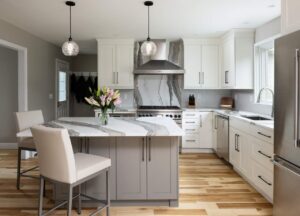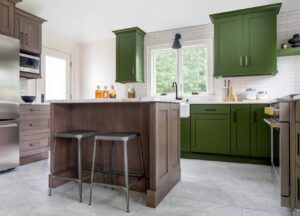
In the world of high-end kitchen remodels, flooring isn’t just about choosing a surface to walk on—it’s about setting the stage for the entire aesthetic and functionality of the space. The right flooring should complement custom cabinetry, support the flow of a luxury design, and withstand daily use while maintaining its appeal. Here, we’ll explore some of the most popular flooring options for upscale kitchens, considering not only their appearance but also their durability, maintenance, and suitability for premium renovations.
Hardwood Flooring: Timeless Elegance With Lasting Appeal
Hardwood flooring remains a favorite in luxury kitchen remodels due to its classic look and ability to add warmth and sophistication to any space. With options ranging from oak and walnut to exotic species like Brazilian cherry, hardwood can be customized through stains, finishes, and plank sizes to align with specific design themes. Beyond aesthetics, hardwood floors are durable, especially when treated with high-quality finishes that resist moisture and scratching.
However, in a kitchen setting, hardwood requires careful consideration. While it can handle foot traffic and the occasional spill, it’s not as moisture-resistant as some other materials. Maintaining its pristine appearance may require refinishing over time, especially in a busy, high-traffic kitchen. For homeowners seeking a high-end look that can transition seamlessly from kitchen to adjacent living areas, hardwood is an excellent choice.
To further elevate the look, consider using wider planks or herringbone patterns to create a more bespoke appearance. Additionally, matte finishes can minimize the visibility of scratches, while engineered hardwood offers greater moisture resistance than traditional solid wood. While hardwood’s initial investment can be higher, the potential for refinishing makes it a long-term asset in luxury kitchen designs.
Porcelain Tile: Versatility Meets Luxury
Porcelain tile has gained traction in premium kitchens for its versatility in design and exceptional durability. It can mimic the look of natural stone, wood, or concrete while offering resistance to water, stains, and heavy foot traffic. With advancements in printing technology, porcelain tiles can replicate intricate patterns and textures, allowing designers to achieve bespoke looks without sacrificing functionality.
Porcelain tile is also easy to clean, making it a practical option for households that prioritize low-maintenance solutions. Additionally, radiant heating can be installed beneath the tiles, adding warmth and comfort to the kitchen—a welcome feature in colder climates. For a truly sophisticated feel, consider large-format porcelain tiles, which minimize grout lines and create a seamless, expansive look.
Beyond standard tiles, porcelain slabs are emerging as a popular choice in luxury remodels. These large, continuous pieces create a sleek, uninterrupted surface that exudes modern elegance. They can be used not only for floors but also for countertops and backsplashes, establishing a cohesive, high-end aesthetic throughout the kitchen.
Natural Stone: Unmatched Luxury And Durability
For those seeking a bold, high-impact statement, natural stone flooring delivers in spades. Options like marble, travertine, and slate bring a level of sophistication that is difficult to replicate with other materials. Each stone type has its unique veining and coloration, ensuring that no two installations are identical.
However, natural stone is porous and requires sealing to prevent staining and moisture absorption. It also tends to be more susceptible to chips and cracks than porcelain. That said, with proper care and maintenance, stone floors can last decades while maintaining their luxurious appeal. In kitchens with open layouts, stone floors can extend seamlessly into dining areas, creating a cohesive, upscale look.

For luxury remodels, polished marble remains a go-to option for its timeless beauty, while honed travertine offers a more understated, rustic aesthetic. Slate provides a striking, earthy appearance that works well in modern and transitional kitchens alike. Incorporating underfloor heating with stone tiles can also enhance comfort and add a touch of indulgence.
Luxury Vinyl Plank: The Practical Choice With High-End Appeal
While luxury vinyl plank (LVP) may not have the historical prestige of hardwood or natural stone, it has evolved into a compelling choice for high-end remodels. Modern LVP mimics the appearance of wood or stone with convincing realism, while also offering superior moisture resistance and ease of maintenance. For homeowners who love the look of hardwood but want a more practical, cost-effective option, LVP can be a perfect fit.
In kitchens, LVP provides a cushioned feel underfoot, making it more comfortable for prolonged standing. Additionally, it’s less prone to scratches and dents, making it an ideal choice for households with pets or children. From a design perspective, LVP can be laid in intricate patterns such as herringbone or chevron, adding an element of visual interest to the space.
High-end LVP options often incorporate enhanced textures, beveled edges, and matte finishes that closely mimic the natural look and feel of authentic wood or stone. Additionally, advanced locking systems simplify installation, making it a convenient choice for remodels that require rapid project completion.
Concrete: Industrial Chic With Endless Customization
Concrete flooring may not be the first material that comes to mind for a luxury kitchen, but with the right finish and design, it can exude modern sophistication. Polished concrete, in particular, offers a sleek, reflective surface that can be tinted or stained to achieve various hues and textures. It’s also incredibly durable and easy to maintain, with the added benefit of compatibility with radiant heating systems.
However, concrete can be unforgiving underfoot and may require area rugs or mats to soften the look and feel. Cracks can also develop over time, but these can be minimized through proper installation and sealing. For kitchens with contemporary or industrial-inspired designs, concrete offers a clean, minimalist aesthetic that stands the test of time.
Stamped concrete adds another layer of customization, allowing for the incorporation of patterns, textures, and even faux finishes that mimic wood or stone. When paired with sleek cabinetry and modern fixtures, concrete flooring can create a striking, upscale look that’s both artistic and functional.
Choosing The Right Flooring For Your Luxury Kitchen Remodel
Selecting the ideal kitchen flooring involves balancing aesthetics, durability, and maintenance needs. At David Hecht Kitchens, we understand that every homeowner’s vision is unique, and we take pride in helping our clients choose materials that align with their design preferences while meeting the functional demands of the kitchen. Whether it’s the timeless appeal of hardwood, the modern sophistication of concrete, or the practical luxury of LVP, our team can guide you through the decision-making process to ensure your new kitchen floor not only enhances the look of your space but also stands up to daily life. Contact us today to learn more about our flooring options and how they can elevate your next kitchen remodel.
